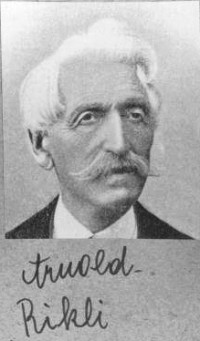Arnold Rikli facts for kids
Quick facts for kids
Arnold Rikli
|
|
|---|---|
 |
|
| Born | 13 February 1823 |
| Died | 30 April 1906 (aged 83) Sankt Thomas, Austro-Hungarian Monarchy (now Austria)
|
| Nationality | Swiss |
| Occupation | physician |
| Known for | naturopathy |
Arnold Rikli (born February 13, 1823 – died April 30, 1906) was a Swiss natural healer. He became famous for his special ways of helping people get well using nature. He also played a big part in making the town of Bled, Slovenia, a popular place for health holidays in the late 1800s. Rikli was also a supporter of a movement called Lebensreform, which means "life reform." This movement focused on healthy living and natural ways.
Contents
Arnold Rikli's Life and Healing Methods
Early Life and a New Path
Arnold Rikli was born into a rich family in Switzerland. He was one of three sons. His father was active in politics and owned a factory. He wanted his sons to learn his business skills. So, he sent Arnold and his brother Karl to a village near Spittal in Austria. There, they built a new factory that dyed leather.
Arnold Rikli got very sick with an upset stomach. He believed his illness was caused by being around the chemicals in the factory. To rest and get better, he went to Bled in Slovenia for the first time in 1852. He felt much better there.
Nature's Doctor: Water, Air, and Sun
After two years in Bled, Rikli started his own healing centers. These centers focused on treatments using sun and water. He left his family's business to follow his new way of healing in Bled. Rikli suggested many therapies. Most of them involved using water, air, and sun on the body.
He believed in swimming in cold water, sunbathing, and walking. He often suggested doing these treatments without clothes. His famous saying was: "Water is good, air is better and most of all the sunlight." Guests at his center stayed in special houses and washed in tubs.
Building a Health Resort in Bled
Rikli was not very popular with the local people in Bled. He never learned the Slovenian language, even though he lived there for 52 years. He also did not accept local customs. Signs and guides in his park were written in German. Locals called Rikli "Švajcar" (Swiss guy) because he was from Switzerland. They also called him "sun doctor" because he promoted sunbathing.
Despite this, Rikli created baths, walking paths, hiking trails, and housing in Bled. In 1895, he built a wooden house and baths in a Swiss style. He also built a hospital with his own examination office.
Rikli's Legacy in Bled
News about Rikli's work spread across Europe. Because of this, a larger swimming area was built in 1899. Soon, Bled started to attract not only people looking for healing but also those who wanted healthy holidays. The number of visitors grew a lot after a railway station was built in Lesce in 1870.
In 1903, Bled won a gold medal at an international fair for healing places in Vienna. By 1906, Bled was known as one of the best tourist spots in the Austro-Hungarian Empire. The healing center continued to operate until World War I, but it was later closed.
Rikli received a statue when he celebrated 50 years of his healing work. Today, Bled still organizes "Rikli's sport days" every July. During this time, hikers walk, run, and climb on the hills above Bled, following Rikli's paths. Rikli's Villa is now protected as a cultural site.
The Arnold Rikli Award
Since 2016, a group in Germany called the Jörg Wolff Foundation has given out the Arnold Rikli Prize every year. This award is worth 10,000 euros. It is given for research about how light affects the human body. The European Society for Photobiology (ESP) supports this award.
Before 2005, another group in the USA, the Light Symposium Foundation, also gave out an Arnold Rikli Prize. This award recognized work that studied how light affects people.
See Also
 In Spanish: Arnold Rikli para niños
In Spanish: Arnold Rikli para niños

